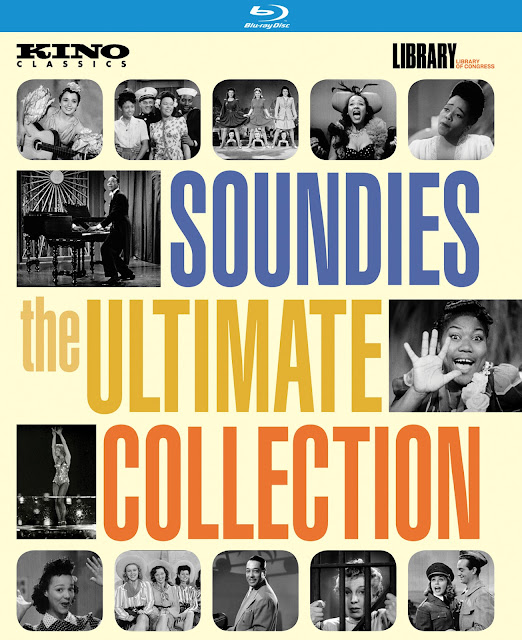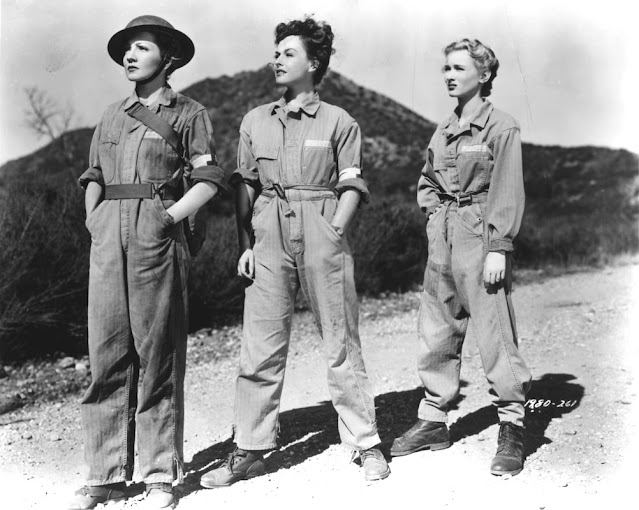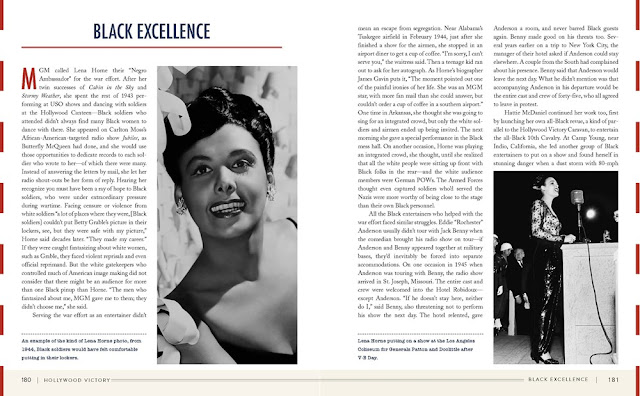For anyone who loves the 1940s music, dance and overall style, discovering Soundies is an absolute treat. What is a Soundie you may be asking? The Soundie was a precursor to the music video. These bite-sized musical short films were the length of a song and featured performers singing, dancing and even acting out skits. Soundies were produced specifically to be played in a Panoram, a coin-operated jukebox with a small screen. These short musicals made on low budgets with up-and-coming talent and highlighted contemporary trends in pop culture. They gained momentum especially during WWII and eventually petered out after the war was over. To me each Soundie is a little window into a bygone era.
 |
| Historian Susan Delson. Photo courtesy of Susan Delson |
Interview with Curator Susan Delson
Raquel Stecher: As a cultural historian, how did you first become interested in Soundies?
Susan Delson: I came across Soundies while writing a previous book, Dudley Murphy, Hollywood Wild Card. It’s a film study and biography of a little-known director whose career crossed over from silent film to sound. Murphy had an adventurous career—from Ballet mécanique to The Emperor Jones—and closed out his Hollywood years by making ten Soundies in 1941.
I started by screening Murphy’s Soundies at the Library of Congress—there weren’t many on YouTube at that point. Then I discovered the breadth of the LC’s Soundies holdings, which are vast. And I was hooked.
Raquel Stecher: It's clear that a lot of thought was put into curating the collection of soundies into different categories for this blu-ray collection. Can you tell me a bit about how each program was curated and what you hope viewers will pay special attention to?
Susan Delson: I spent years screening and researching Soundies before I began writing my book, Soundies and the Changing Image of Black Americans on Screen: One Dime at a Time. I’d been a film programmer in the past, and right from the start, potential program themes were part of my Soundies thinking. I figured I’d present these films eventually, one way or another.
As I started programming the Kino Lorber set, I knew that I wanted to explore the full scope of the history embedded in the films—American history, African American history, entertainment history, and especially the change-making undercurrents in the culture back then. Soundies are a terrific way of getting into all of that—and at the same time, a lot of fun.
Each of the four [Blu-rays] in the set has its own theme, and those took shape pretty quickly: Introducing Soundies, Life in the Soundies Era, Musical Evolutions, and Women, Sexuality, and Gender.
There are six eight-film programs on each [Blu-ray], and all of them explore a different aspect of that disc’s theme. Except for the last program on each disc, called “Straight from the Panoram.” With those, I re-created an eight-film reel exactly as the Soundies Corporation released it back then—a program from a different year on each disc.
In response to your question, what I hope viewers will pay attention to is probably all of the above—the history, the cultural undercurrents, and above all, the fun. I also hope they discover lots of terrific performers they hadn’t known about. For me, that was one of the most exciting things about the whole project.
Raquel Stecher: I was particularly interested in the Soundies programs that reflected different aspects of American life during WWII. How do these Soundies give viewers a window into the culture of that era?
Susan Delson: There’s an immediacy to Soundies’ depiction of home-front life that you don’t generally get in Hollywood movies of that era. There’s nothing quite like Louis Jordan making sly double-entendres in Ration Blues to give you a sense of what living with wartime rationing might have been like. Or the Pretty Priorities (what a name!) doing a joking, patriotic strip tease to support scrap drives for the war effort in Take It Off.
In many films, there’s a creative, playful attention to personal style—this was the zoot suit era, after all. There’s a focus on dance, too, which makes sense when you realize that in the 1940s everyone danced, whether it was the foxtrot, the samba, or the jitterbug. There are some Soundies, like Hot Chocolate (“Cottontail”) or Swing for Sale, that people might have watched over and over just to pick up some new dance moves.
The company behind Soundies—the Soundies Distributing Corporation of America— released a new eight-film reel every week. That’s over 400 films a year. They had to keep pace with popular culture, if only to keep the product flowing. The films had to be made quickly and cheaply. And with little or no time for rehearsal, let alone directorial vision, performers often had a lot of say in how they presented themselves on screen—much more than they might have had in Hollywood. With Soundies, you get a street-level, pop-culture perspective that you don’t get in mainstream media of the day.
Raquel Stecher: The blu-ray set features a diverse mix of Soundies with Black, Asian and Latino performers. I was particularly delighted to see Soundies featuring Dorothy Dandridge, the Mills Brothers, Ricardo Montalban, Nat King Cole and more. Can you talk a bit about why this was important and what you believe are some of the highlights of the collection?
Susan Delson: The diversity you’re talking about is really important. It’s what distinguishes Soundies from most of 1940s popular culture, and I’d say it’s the main concept behind the whole Kino Lorber set.
As you can see in the [Blu-rays], the Soundies Corporation was committed to presenting a diverse array of talent. Not out of idealism or altruism—they were a business and they absolutely wanted to make money. But the Soundies Corporation recognized an underserved audience when they saw one, and they knew there was a market for films that showed, on screen, a more complete view of who we were back then—Black, Latinx, Hawaiian, Asian, Eastern European, and more. There’s so much talent here that doesn’t appear on screen anywhere else during these years.
Among the highlights, I’d have to start with the first film on disc 1, Duke Ellington’s Jam Session. It’s by far the most popular Soundie online, closing in on 3 million YouTube views (mostly under the title “C Jam Blues,” which is the number the band is playing). Dorothy Dandridge’s Soundies are another highlight—she was 19 when she made them, and she’s absolutely incandescent.
Then there are the discoveries. The vocal harmony trio Day, Dawn, and Dusk has such a smart, sophisticated take on high culture, on American history, and gender play. We have three of their Soundies in the set, and every one is a gem.
My colleague Ina Archer, who does some of the on-camera intros in the set, calls another vocal harmony group, the Delta Rhythm Boys, the house band for Soundies. I agree. They really set the style for Soundies produced in New York, and they’re wonderful to watch.
Raquel Stecher: I have so many favorites from this collection, especially Hot Chocolate, Paper Doll, Frim Fram Sauce, Johnny Zero, etc. What are some of your personal favorites?
Susan Delson: All of the ones you mention are terrific. I also love Along the Navajo Trail, with John Shadrack Horace and Johnny Moore’s 3 Blazers. It’s the only country-western Soundie I came across that stars Black performers, and they’re great. Sticking with country-western, I also love Why Did I Fall for Abner, with Carolina Cotton and Merle Haggard. Everyone looks like they had a terrific time shooting that one—including the all-woman backup band, the Glee Gates Trio with two additional musicians. They’re terrific.
I also have a soft spot for Soundies that make me laugh, like A Little Jive Is Good for You and Operatin’ Rhythm. And just about all the films on disc 4 that explore women’s sexuality and gender play.
Raquel Stecher: What do you hope viewers will get out of watching Soundies: The Ultimate Collection?
Susan Delson: I hope the films will add some nuance and complexity to our thinking about the World War II years, beyond the “Greatest Generation” gloss. The culture back then was a lot more complicated and contradictory than people might think—emphasis on contradictory—and we see that in the films.
In my introductory essay in the [Blu-ray] booklet, I write that Soundies speak in multiple voices, and they don’t all say the same thing. For me, that’s a real plus. If there’s one thing I hope viewers take away from Soundies: The Ultimate Collection, it’s that our country is, and long has been, a place of multiple voices, cultures, and peoples.
With these films, you really get the sense that as a nation, our diversity is our strength. And they make that point in a way that’s fun to watch and listen to. I hope everyone has as much fun with these films as I had in putting the programs together.
Amazon — Barnes and Noble — Deep Discount —Kino Lorber




































